It was evening before my brother Lance and I set out from our campsite on Hawk Island at the northern end of Ontario’s Georgian Bay. We had been windbound all day, our boats anchored just off the cobblestone beach on the island’s north side. Finally, in a moment of dubious optimism based on nothing more than a brief lull and a purely theoretical expectation of a favorable wind shift, we shoved off to give it a try.It was a poor choice. As we passed the rocky point sheltering our anchorage, the wind revealed its full brutality, with frequent gusts that must have been nearing 30 knots. Even double-reefed, FOGG, my Don Kurylko–designed Alaska, was pushed rail-down again and again. Each time it happened, a few liters of cold water poured in before I could ease the sheet enough to bring us upright. Lance had come about onto a starboard tack in his Ross Lillistone–designed Phoenix III and was somewhere behind me, headed offshore—I was too busy to keep track of him more closely than that.I was reasonably confident that I could reach the mainland 2 miles north, even in these conditions, but I had no desire to try it. I had foolishly neglected to don my foulweather bibs and rain jacket and being cold and wet was doing nothing to increase my enthusiasm. When yet another gust came close to knocking us down, I headed up into the wind and dropped the rig in a fluttering tangle of sailcloth and spars, hoping that Lance wouldn’t think I had capsized. Then, immediate crisis averted, I carefully un-stepped the mast, laid it across the thwarts, and started rowing back toward the beach I had left just a few minutes ago. Lance, I saw, was already safely ashore, with the Phoenix III back at anchor—he must have turned back almost immediately.
Join The Conversation
We welcome your comments about this article. To include a photo with your remarks, click Choose File below the Comment box.



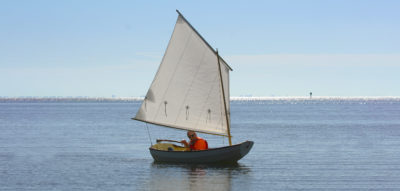


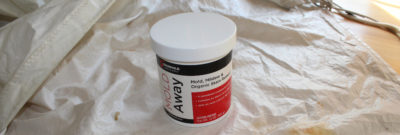
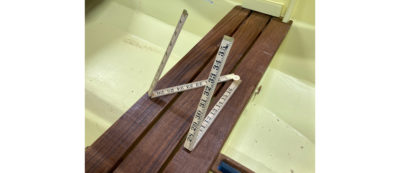

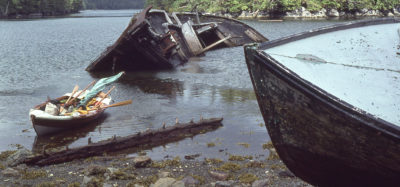
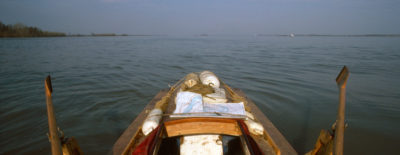
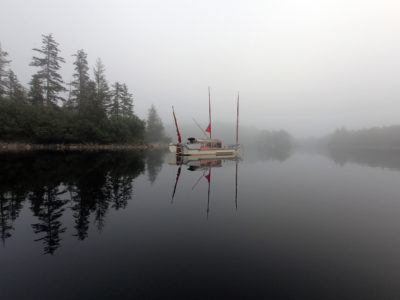
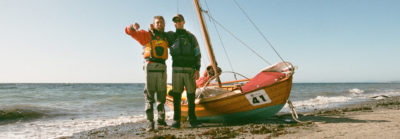
I LOVE IT!
Thank you for this vivid account!
Chris
Interesting account, great pictures, thanks!
Great stuff, as usual, Tom. If ’twere in my power I’d grant you Canadian citizenship, and a job, so you could continue to provide us with more explorations of Canadian waters.
Another great adventure story Tom! I’m trying to follow along on Google Maps, but it’s not easy as most of the island names do not show. Knowing you, there is no GPS track, either 😉
Rick, if you click on the diagram/map above it will enlarge. You can move that to a second screen if you have one and then track it on google maps.
I second all the positive comments.
Sounds like you had some challenging conditions! I’m curious, would you put your decision to go out in the bigger wind and waves in the “bonehead move” category or would you do it again? (I ask from the standpoint of an experienced bonehead-mover.) Was the chance of capsize/swamping quite low, or something that was very possible? Could you have recovered the boat from a capsize in those conditions, and if so, how? If one of you ended up in the water, would it be possible to get into the other’s boat without bringing it to grief? How long do you think you could have lasted in the water, given the clothing you had on and the condition and temperature of the water? Was self rescue your only option, or did you have access to emergency communications? Any precautions you took, or wish you had taken, that might be helpful for other readers to consider?
Thanks in advance.
OK, great questions from Andrew on safety and risk management. Here’s my thinking:
1. It was definitely the wrong move to go out in those conditions when we set out from Hen Island. The main reason we did was that Hen Island’s bay is completely sheltered from any direction but northeast, so we never noticed the southwest swell building all afternoon after we landed there. Had I known it was going to be such big waves, I would not have gone out.
In fact, I really didn’t even want to go out even before I saw the waves, because I was worried about how quickly the fog had come in. But we were under some time pressure on this trip. I think that’s generally a mistake; an open calendar and refusal to impose deadlines is, I’d argue, the best small boat safety measure there is. But reality is, Lance had to get back to work so covering more miles (if we could) seemed important. On my own, I probably would have camped overnight because of the fog risk. That would have been the smartest way to handle the situation. Then again, with the next day’s super-high westerly winds, we REALLY would have missed our deadline had we not gone on. Deadlines are dangerous. They cause us to underestimate risk, I think. Or accept a higher level of risk to avoid an inconvenience that’s otherwise certainly going to affect us.
2. Once out in these waves with the sail up, I thought there would be more risk NOT continuing than there would be in pressing on–trying to gybe (or tack) my way around to go back to Hen Island felt like it would have been a very risky maneuver. Trying to drop the sail seemed even riskier–with no mizzen, the boat would have turned broadside. And these waves were easily big enough to capsize us if we were beam-on to them. Also, where I hoisted the sail, I had very little sea room before I’d hit rocks–I kind of had to begin sailing immediately, and didn’t want to gybe without room anyway. (Maybe making sure you have more sea room in the first place would be wise!)
But it was immediately apparent that the Alaska (and the Phoenix III) were doing pretty well by taking the waves on a close reach, angling up the faces, and easing the sheet in gusts. So, knowing we had only to hold the heading for 2-3 miles before we’d be past the shoals (and theoretically past the big waves), I thought keeping on was the best choice at that point. The wind, interestingly, did not seem particularly strong. Lance wasn’t reefed in the Phoenix III, and I didn’t feel overpowered in the Alaska either. Even so, these were conditions where a mistake, or a moment’s inattention, or even a particularly unlucky big wave at the wrong moment, could have capsized either boat. But without pilot error, I think a capsize would have been unlikely even in these waves.
3. The water in Georgian Bay is significantly warmer than in the rest of Lake Huron, or Lake Michigan/Lake Superior. In July, I typically swim for an hour or more each evening. That said, it was colder on this trip (early June), so it definitely would have been a serious concern to capsize. I have a drysuit but the gaskets need repairing, so I didn’t bring it. My foul-weather pants and rain jacket would not have helped nearly as much.
4. I am confident about solo recovery of either boat–we’ve tested them in actual sailing conditions. That said, with these waves, I think it very likely they could have re-capsized before I could re-board and bail. Capsizing in high winds but smaller waves would be far less of a problem–in that case, I could drop the rig and re-board to continue under oars.
5. Self-rescue was our only option had we capsized–no VHF. I’m not opposed to them, but I think that the chances anyone would be in range to receive a distress call would be low. I’d rather put the time into attempting a self-rescue than in trying to call for help. And if I re-right the boat first and then take time to use the VHF, I wouldn’t need rescue anymore. So I don’t find myself thinking a radio would have been of much use. We only saw other boats on the first day of this trip, so it’s always best to assume you’re on your own.
I think either Lance or I could have rescued the other person had one of us gotten into trouble. Not so sure we could have helped much with the boat. We probably would have tried to stand by while the other person attempted to re-right the boat alone, and adjusted plans depending on how that turned out. Certainly there’s no easy way to coordinate two boats in serious conditions, or to work together on a re-righting.
Bottom line: Avoid deadlines. Stay ashore. And trust your boat and experience to see you through if you get into something bad anyway. A bit of luck when you need it doesn’t hurt either!
Tom
Thanks for all the comments; I really appreciate them. I’ll try to post some detailed responses soon. Great questions about the challenging conditions. I look forward to sharing my thoughts.
Tom
Thanks Andrew. On my phone the map image did not appear to show any tracks, but on a big screen I see Tom did use a GPS.
Actually, that’s not a GPS track–I don’t own one, and my brother didn’t bring his. The route from the map is the one I plotted after the fact on Google Earth so the illustrator had something to work with for the article. It’s as accurate as my memory, notes, and photos can make it, but it’s not GPS. Given how narrow some of those channels are, though—and how good Google Earth is—I’d expect the route as marked to be pretty precise.
Tom
Happy to hear you did not have a GPS, I was worried you had gone to the dark side!
Regarding the waves – were they breaking? On my very similar size Walkabout, I would resist letting the boat turn beam on in waves as it seemed more dangerous. Recently I’ve been more relaxed, and found it will ride over most waves from big swells to steep chop as long as they are not curling over. I sit near center and let it rock. Little boats can be better than big in many conditions.
Rick,
I suspect I will resist the “dark side” of electronics pretty strongly as long as I’m doing this kind of sailing! There are places where it makes sense for sure, especially if you’re dealing with significant currents, but that’s not the case on the Great Lakes at all.
As for the waves, mostly they were not breaking, though a few of them broke decisively, and many of them had breaking crests that would dump water in over the gunwale. So, as you say, my boat (small and light) might have handled them fine, even beam-on. I think the bigger danger (of dropping the rig without a mizzen to hold the boat head-to-wind) would have been of me falling out, or falling down and being injured. And while I suspect you’re right that a small boat can “floating-leaf” its way over most waves without trouble, these waves were big enough, and steep enough, that “better safe than sorry” seemed to apply.
That said, there were occasional waves (as always) that were much bigger than the average size, maybe one “rogue” every 2-3 minutes. I felt like 2 things were especially important for these waves:
1. Maintaining steerage—enough speed to have decisive control over the boat, so keeping the sail powered up (I was easing the sheet a lot, almost luffing, very often, but not when these bigger waves appeared).
and
2. Steering as close to directly up the wave face as possible without letting the sail luff.
I think what really helped was that, while the swell was still big (big enough for each boat to be completely hidden in the troughs), the wind was dropping off. I had a single reef tied in, and would probably have managed fine under full sail.
I was actually quite surprised by how well the boats handled it, as it certainly seemed scary to me. My conclusion is that, handled properly, the risk of capsize was pretty low in these conditions—but that a mistake could have quite easily resulted in a capsize. We were definitely paying attention! (And would not have gone out had we known what we were getting into).
Tom
Thanks for the details Tom. As always, it’s enjoyable to ride alone with you on your adventures. I’ve sailed 1x out of Little Current on a 32′ Cat with my brothers…hardly the same thing, but that trip has resulted in my bucket list addition of getting back out there with my Welsford Navigator.
A Navigator would be a great boat for Georgian Bay, for sure. It would be very hard to explore some of that inshore terrain in a bigger boat–maybe impossible.
Tom
Tom–What a great story! I love your adventures and I smile when enjoying your writing style, self-deprecating and all. Keep up the adventures and don’t forget to get around a boat or some water in Europe!
Jay, we still have to manage a sailing trip together at some point (what are you doing next summer?). It’s great to hear from you–thanks for commenting!
Tom
Great adventure (wonderful photos!) for sure but, I think I envy all that you and Lance have done together as “brothers” the most! That said, like everyone else I’ll be looking forward to your next article.
Stay well Across the Pond,
Rob K
Thanks for the comment, Rob. I agree, it’s great to have a brother interested in doing the same kinds of things–having another person along dilutes the potential for terror a bit. But solo trips are also good. Either way, I still need to get my hands on a boat somehow over here…
Tom